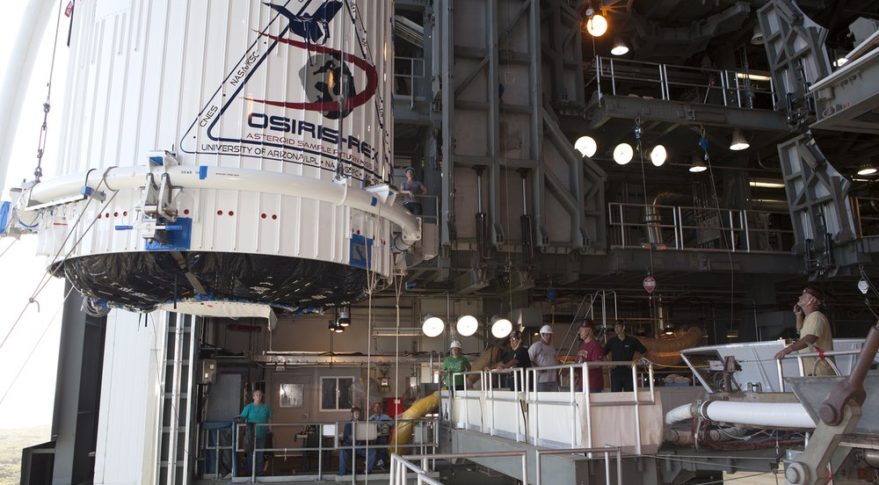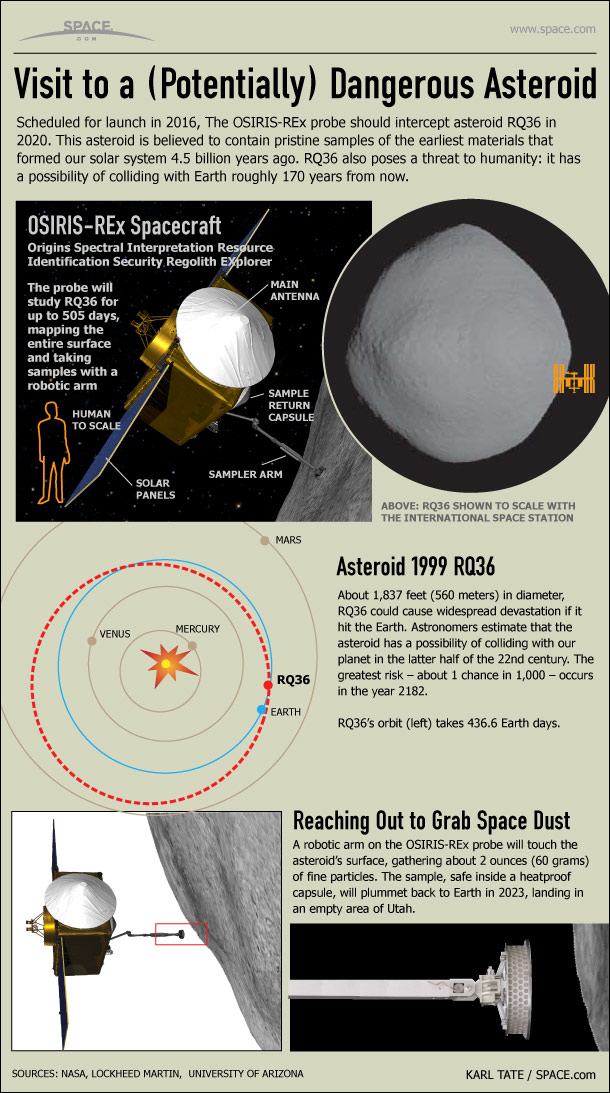How to Follow NASA's Asteroid-Sampling Mission Launch Online This Week

You can learn all about the asteroid-sampling mission of NASA's OSIRIS-REx spacecraft before the probe blasts off Thursday evening (Sept. 8).
NASA will webcast a number of news conferences this week leading up to the launch of OSIRIS-REx, which is expected to arrive at the 1,650-foot-wide (500 meters) asteroid Bennu in 2018 and return a sample of the space rock to Earth by 2023.
All events, including the probe's liftoff, will air live on NASA TV; you can also watch the OSIRIS-REx webcasts here at Space.com, courtesy of NASA TV. Social media followers can participate in briefings using the hashtag #askNASA. [Osiris-Rex: NASA's Asteroid Sample-Return Mission in Pictures]
Here are the schedule highlights:
Tuesday, Sept. 6: 1 p.m. EDT (5 p.m. GMT)
Prelaunch mission briefing at NASA's Kennedy Space Center (KSC) in Florida. The briefing participants are:
- Geoffrey Yoder, acting associate administrator of NASA’s science mission directorate in Washington, D.C.
- Dante Lauretta, OSIRIS-REx principal investigator at the University of Arizona, Tucson
- Tim Dunn, NASA launch manager at the Kennedy Space Center
- Scott Messer, program manager for NASA missions at United Launch Alliance in Centennial, Colorado
- Michael Donnelly, OSIRIS-REx project manager at NASA's Goddard Space Flight Center in Maryland
- Rich Kuhns, OSIRIS-REx program manager for Lockheed Martin Space Systems in Denver
- Clay Flinn, launch weather officer for the 45th Weather Squadron at Cape Canaveral Air Force Station, Florida
Tuesday, Sept. 6: 2 p.m. EDT (6 p.m. GMT)
Breaking space news, the latest updates on rocket launches, skywatching events and more!

OSIRIS-REx mission science briefing at KSC. Briefing participants are:
- Christina Richey, OSIRIS-REx deputy program scientist at NASA headquarters in Washington, D.C.
- Jason Dworkin, OSIRIS-REx project scientist at NASA's Goddard Space Flight Center in Maryland
- Daniella DellaGiustina, OSIRIS-REx lead image processing scientist at the University of Arizona, Tucson
Wednesday, Sept. 7: 12 p.m. EDT (4 p.m. GMT)
OSIRIS-REx Talk from KSC's Operations Support Building II. The spacecraft's science and engineering teams will participate in the talk, discussing the mission's science goals.
Wednesday, Sept. 7: 1 p.m. EDT (5 p.m. GMT)
Uncovering the secrets of asteroids: A discussion about what asteroids are and why they are important to understand the solar system's history and the search for life beyond Earth. Participants at KSC's Operations Support Building II are:
- Ellen Stofan, NASA chief scientist
- Michelle Thaller, deputy director of science communications for NASA's Science Mission Directorate
- Lindley Johnson, director of the Planetary Defense Coordination Office in NASA's Science Mission Directorate
- Alex Young, associate director for science in the Heliophysics Science Division at NASA's Goddard Space Flight Center in Maryland
Sometime on this same day, NASA plans to put a prelaunch webcast up on the agency's YouTube channel: https://www.youtube.com/NASAtelevision
Thursday, Sept. 8: 4:30 p.m. EDT (8:30 p.m. GMT)
Launch coverage begins, starting with the loading of cryogenic fuel into the United Launch Alliance Atlas V rocket that will carry OSIRIS-REx skyward. Coverage will continue until about 1 hour after launch. The launch window extends from 7:05 p.m. to 9:05 p.m. EDT (11:05 p.m. Sept. 8 to 1:05 a.m. Sept. 9 GMT).
Two hours after launch, there will be a post-launch news conference that will include representatives from NASA and United Launch Alliance.
OSIRIS-REx is short for Origins, Spectral Interpretation, Resource Identification, Security, Regolith Explorer. The $800 million mission's main goal is to learn more about the role asteroids like Bennu may have played in bringing life's building blocks to Earth.
The probe's observations should also help researchers accomplish three other goals: nail down the orbit of Bennu, which has a slight chance of hitting Earth in the late 22nd century; learn more about the forces that affect asteroids' paths through space; and shed light on the resources space rocks may harbor, NASA officials have said.
Follow Elizabeth Howell @howellspace, or Space.com @Spacedotcom. We're also on Facebookand Google+. Original article on Space.com.
Join our Space Forums to keep talking space on the latest missions, night sky and more! And if you have a news tip, correction or comment, let us know at: community@space.com.

Elizabeth Howell (she/her), Ph.D., was a staff writer in the spaceflight channel between 2022 and 2024 specializing in Canadian space news. She was contributing writer for Space.com for 10 years from 2012 to 2024. Elizabeth's reporting includes multiple exclusives with the White House, leading world coverage about a lost-and-found space tomato on the International Space Station, witnessing five human spaceflight launches on two continents, flying parabolic, working inside a spacesuit, and participating in a simulated Mars mission. Her latest book, "Why Am I Taller?" (ECW Press, 2022) is co-written with astronaut Dave Williams.
